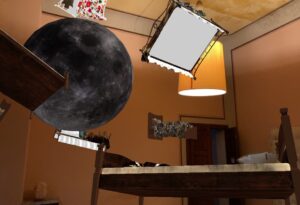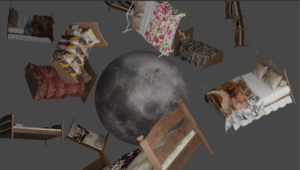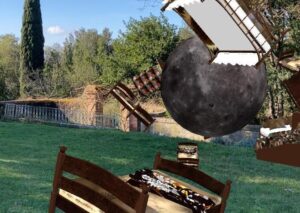I met Nouf Alhimiary (*1992, Jeddah, KSA) on the occasion of PARALLEL, the first augmented reality exhibition project promoted by Saudi Arabia’s Ministry of Culture that I curated in 2022 and in which I involved her along with nine other international artists. In this interview, I catch up with Nouf – this time in Italy – to talk about “Resting Place” (2023), the unreleased work made in AR during her summer residency at Villa Lena. Continuing her research focused on the relationship between technology, spirituality and collective rituality, Nouf tells me about the strong connection of this work with the context of the Villa and the main elements on which she decided to develop the work.

Nouf Alhimiary at Villa Lena, 2023, courtesy Villa Lena Foundation
Federico Montagna: As I delved deeper into the history of Villa Lena, I was immediately struck by the uniqueness of this estate surrounded by nature that had its heyday in the 19th century but has roots even in the Middle Ages. I imagine that experiencing this place inevitably conveyed something to you. What did your attention focus on during the residency that later led you to develop the work “Resting Place”?
Nouf Alhimiary: The history of Villa Lena fascinated me from the very beginning because it has always been a space of passage, full of stories, lives and connections, those of people who have stopped in this place even if only for one night. For this reason, my attention was immediately focused on an element that strongly characterizes the place of the villa, that of the “bed”. A subject that, by the way, I have always found fascinating because it is a symbol of a safe and private intimacy that we all have, however, and that lies exactly in that liminal space between reality and dream. Even the poem that I recite in the background and that accompanies the work, is conceived precisely as a lullaby to immerse the viewer in a surreal dimension, between the known and the subconscious.

Nouf Alhimiary, “Resting Place”, 2023, courtesy Villa Lena Foundation
“Resting Place” seems to me to be a site-specific AR artwork. Although augmented reality can be adapted to any context and space, in fact, the elements you have developed have a clear desire to speak of a very specific reality, that of Villa Lena and, above all, of the human experience linked to that specific place. Even the idea of choosing the garden of the villa as the preferred space for the fruition of the work is yet another proof of this.
That’s right, I conceived “Resting Place” with a very specific place in mind even for its fruition, that of the Garden. It is a pristine and secret space at the back of the villa, which by the way had never been geolocated before, so I had to digitize its presence according to a long process that could allow me to be able to use it as a “safe area” for my work. This made me think a lot not only about the characteristics of this place, disconnected from a technological point of view but rich in connections created over numerous years and still palpable within the spaces of the villa, but also about the ethical aspect of these devices: who decides that an area is safe and recognized for geolocation? How does a place have to adapt to be “approved” by technology?

Screenshot showing artifacts for “Resting Place” by Nouf Alhimiary, 2023, taken from Blender
Did you want to develop the work in AR because you were interested in making this experience collective?
I think that being accessible is not always a positive and necessary factor; in fact, I believe that one’s private and personal experience should be protected. For this reason, the choice to use this medium was not so much dictated by the desire to make the work as accessible as possible, but more by unveiling something invisible, to project it in front of the viewer’s eyes to allow him or her to have an experience that can break down all physical and real limits. All of this, I believe, is not only about virtual involvement and interaction, but also and above all spiritua.

Nouf Alhimiary, “Resting Place”, 2023, courtesy Villa Lena Foundation
As in the group exhibition I curated in Saudi Arabia in 2022, here you present an AR artwork in which the relational part is both intriguing and disturbing, familiar and mysterious. “Perturbing” is perhaps the best term to describe it. Here, however, there is an extra component that I found very interesting: the sound. Can you tell me more about this aspect within the work?
The recorded voice that can be heard is mine and I worked with the music producer Bassi Fox to make the sound “non-human” and disturbing. The text of the poem I recite refers specifically to the liminal space that exists between the waking and sleeping states, as if it were a portal between two dimensions that is impossible to grasp and describe precisely because it is out of our control: we don’t decide to fall asleep, it just happens. This made me think, once again, of how this dwelling was in effect a portal not only physical (it was precisely a crossroads of passage) but also spiritual. The same artists who have participated in this residency over the years have left a mark, a trace in this place through their works.
Therefore, was Villa Lena for you a “resting place” understood as a space of meditation?
For me every place can be a space of meditation understood as a moment of reflection, and so absolutely yes, it was. Especially because I inevitably found myself thinking so much about myself and how I could develop my work. However, I think the idea of rest, and even in the text of the poem this is clearly perceived, is also related to a time when, as when you are alone at night in your bed, all your thoughts, all your insecurities and all your fears come to the surface. Rest thus understood as an opportunity to confront with ourselves..
Federico Montagna
Info:
Villa Lena
via comunale di Toiano 42, 56036 Palaia PI
VillaLena.org

is a contemporary art magazine since 1980






NO COMMENT